Agwa

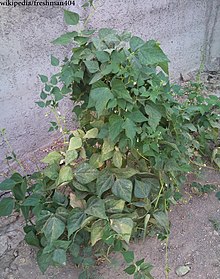

Agwa bụ mkpụrụ nke ọtụtụ osisi n'ezinụlọ Fabaceae, nke a na-eji dị ka akwụkwọ nri maka nri mmadụ ma ọ bụ anụmanụ.[1] Enwere ike isi ha n'ọtụtụ ụzọ dị iche iche, gụnyere isi nri, isi nri, na isi nri, ma jiri ha mee ihe n'ọtụtụ nri ọdịnala n'ụwa niile.[2]
Okwu okwu
[dezie | dezie ebe o si]5Okwu ahụ bụ "bean" na okwu German ya (dịka. German Bohne) adịwo na-ejikarị eme ihe n'asụsụ West German kemgbe tupu narị afọ nke iri na abụọ, na-ezo aka na agwa sara mbara, chickpeas, na mkpụrụ osisi ndị ọzọ. Nke a bụ ogologo oge tupu a mara ụdị New World Phaseolus na Europe. Site na mgbanwe Columbian nke osisi ụlọ n'etiti Europe na Amerịka, a gbatịkwuru okwu ahụ na mkpụrụ osisi nke Phaseolus, dị ka ọka na ọka na-agba ọsọ, na ụdị Vigna. Ọ dịla anya a na-eji okwu ahụ eme ihe n'ozuzu ya na ọtụtụ mkpụrụ ndị ọzọ yiri ya, dị ka Old World soybeans, peas, vetches ndị ọzọ, na lupins, na ọbụna ndị yiri ibe ha, dị ka kọfị, vanilla beans, castor beans, na cocoa beans.[3] N'ihi ya, okwu ahụ bụ "bean" n'ozuzu ya nwere ike izo aka n'ọtụtụ ụdị dị iche iche.[4]
A na-etinyekarị mkpụrụ ndị a na-akpọ "beans" n'etiti ihe ọkụkụ ndị a na'akpọ "pulses" (legumes), ọ bụ ezie na okwu ndị ahụ anaghị agbanwe mgbe niile (iji ya eme ihe dịgasị iche site na ụdị osisi na mpaghara). Okwu abụọ ahụ, agwa na pulses, na-echekwa maka ihe ọkụkụ ma si otú a wepụ akwụkwọ nri ndị nwere obere mkpụrụ ma jiri ya mee ihe maka ebumnuche na-abụghị ọka (forage, hay, na silage), dị ka clover na alfalfa. Òtù Nri na Ọrụ Ugbo nke Mba Ndị Dị n'Otu na-akọwa "BEANS, DRY" (koodu isiokwu 176) dị ka nke metụtara naanị ụdị faseolus.[4] Nke a bụ otu n'ime ihe atụ dị iche iche nke otu okwu dị warara nke a na-eme ka ọ dị na iwu azụmahịa ma ọ bụ ihe ikuku na-adịkarị n'asụsụ okike na ihe omimi sara mbara na ojiji nri; ihe atụ ndị ọzọ a na-ahụkarị bụ ihe omimi nke okwu nut na ihe omuma sara mbara nke okwu <i id="mwVA">nut</i>, na eziokwu ahụ bụ na tomato bụ mkpụrụ osisi, ma a na-emekarị ha dị ka akwụkwọ nri na ojiji n'ozuzu. N'ụzọ yiri nke ahụ, nkọwa ọzọ nke ojiji bụ na ọtụtụ ụdị osisi ndị a na-akpọ agwa mgbe ụfọdụ, gụnyere Vigna angularis (azuki bean), mungo (black gram), radiata (green gram), na aconitifolia (moth bean), bụ ndị e kewara dị ka Phaseolus ma mesịa gbanwee ya - mana nyocha taxonomic anaghị akwụsị kpamkpam ojiji nke mmetụta guzosiri ike n'ozuzu.
Izulite
[dezie | dezie ebe o si]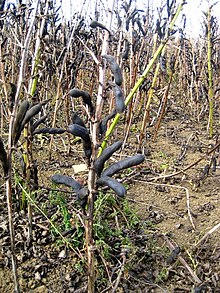
Unlike the closely related pea beans are a summer crop that needs warm temperatures to grow legumes are capable of nitrogen fixation and hence need less fertiliser than most plants
Maturity is typically 55-60 days from planting to harvest as the beans pods mature they turn yellow and dry you and the beans inside change from green to their nature colour
N'oge ndị na-adịbeghị anya, e mepụtara ihe a na-akpọ "agwa ohia " nke na-achọghị nkwado ma nwee pods ya niile na-eto n'otu oge (dị iche na agwa osisi nke na-eto nke nta nke nta).[5] Nke a na-eme ka ahịhịa dịkwuo mma maka mmepụta azụmahịa.
Akụkọ ihe mere eme
[dezie | dezie ebe o si]
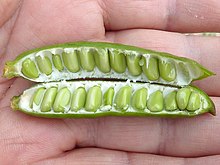


Agwa bụ isi iyi dị mkpa nke protein n'akụkọ ihe mere eme nke Old na New World, ma ka dị taa.
Agwa bụ otu n'ime osisi ndị a na-akụ ogologo oge n'akụkọ ihe mere eme. Mkpụrụ ọka buru ibu, nke a na-akpọkwa mkpụrụ ọka fava, dị n'ọhịa ha dịka obere mbọ mkpịsị aka, a chịkọtakwara ya na Afghanistan na ala ugwu Himalayan.[6] A zụlitere ụdị mbụ a zụliere na Thailand site na mmalite puku afọ nke asaa BCE, tupu ite.[7] A na-etinye ọka na ndị nwụrụ anwụ n'Ijipt oge ochie. Ọ bụghị ruo na puku afọ nke abụọ BCE ka a kụrụ, nnukwu mkpụrụ osisi buru ibu pụtara na mpaghara Aegean, Iberia, na transalpine Europe. Na Iliad (narị afọ nke asatọ BCE), a na-ekwu maka agwa na chickpeas a tụbara n'ala ahịhịa.[8]
A chọtara ọka ọka ọka kachasị ochie a maara na Amerịka na Guitarrero Cave, ebe nchọpụta ihe ochie na Peru, ma dee ya na puku afọ nke abụọ BCE. Otú ọ dị, nyocha nke mkpụrụ ndụ ihe nketa nke mkpụrụ osisi faseolus na-egosi na ọ malitere na Mesoamerica, ma mesịa gbasaa n'ebe ndịda, tinyere ọka na squash, ihe ọkụkụ ndị enyi ọdịnala.[9]
Ọtụtụ n'ime ụdị agwa a na-eri taa bụ akụkụ nke ụdị faseolus, nke malitere na Amerịka. Onye Europe mbụ zutere ha bụ Christopher Columbus, mgbe ọ na-enyocha ihe nwere ike ịbụ Bahamas, ma hụ ha na-eto n'ọhịa. Ụdị ọka Phaseolus ise bụ ndị ndị ndị pre-Columbian zụlitere: ọka ọka nkịtị (P. vulgaris) nke a zụliere site na Chile ruo n'akụkụ ugwu nke ihe bụ United States ugbu a; na ọka lima na sieva (P. lunatus); yana ọka teparies a na-ekesa nke ọma (P. acutifolius), ọka na-acha uhie (P. coccineus), na ọka polyanthus.[10][11]
Otu uru agwa bara nke echekwara echekwa nke pre-Columbian mmadu as far north as the Atlantic seaboard is the "umunne ndi nwanyi " usoro of companion plant cultivation:agwuru buru ibu ka akokota agwa na oka(corn), and squash. The oka would not be planted in rows as is done by European agriculture, but in a checkerboard/hex fashion across a field, in separate patches of one to six stalks each. Beans would be planted around the base of the developing stalks, and would vine their way up as the stalks grew. All American agwa at that time were vine plants; "agwa ohia" were cultivated more recently. The cornstalks would work as a trellis for the agwa, and the beans would provide much-needed nitrogen for the corn. Squash would be planted in the spaces between the patches of corn in the field. They would be provided slight shelter from the anwu by the oka, would shade the soil and reduce evaporation, and would deter otutu umu anumanu from attacking the oka and agwabecause their coarse, hairy vines and broad, stiff leaves are difficult or uncomfortable for animals such as deer and raccoons to walk through, crows to land on, and are a deterrent to other animals as well.
A na-akụ ọka n'ofe Chile n'oge Pre-Hispanic, ma eleghị anya ruo n'ebe ndịda Chiloé Archipelago.[12]
Mkpụrụ ọka kpọrọ nkụ sitere na ụdị ọka ọka ochie (mkpụrụ ọka fava) na ụdị ọka ọhụrụ (mkpụrụ osisi kidney, black, cranberry, pinto, navy/haricot).
Ụdị na ụdị ndị a na-ahụkarị
[dezie | dezie ebe o si]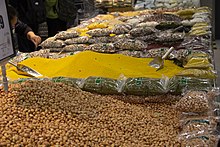
Ka ọ dị ugbu a, ụlọ akụ mkpụrụ ndụ ihe nketa ụwa nwere ihe dị ka ụdị mkpụrụ osisi 40,000, ọ bụ ezie na ọ bụ naanị akụkụ ole na ole ka a na-emepụta maka oriri mgbe niile.[13]
Ọtụtụ n'ime nri anyị na-akpọ "beans", "legumes", "lentils" na "pulses" sitere n'otu ezinụlọ, Fabaceae ("leginous" osisi), mana sitere na ụdị na ụdị dị iche iche, sitere na ala nna dị iche iche ma kesaa n'ụwa niile dabere na mgbanwe ha.[14] A na-eri ọtụtụ ụdị ma dị ọhụrụ (ọka ahụ dum, na agwa ndị na-eto eto nwere ike ma ọ bụ na ha agaghị adị n'ime) ma ọ bụ nwee mkpokoro (mkpụrụ ndị na-etubeghị eto, mkpụrụ ndị tozuru etozu na ndị ọhụrụ, ma ọ bụ mkpụrụ ndị tozoro etozu na nke a kpọrọ nkụ). Ọtụtụ akwụkwọ nri yiri, ma bụrụ nke a na-ahụkarị n'ebe dị iche iche n'ụwa, nke na-edugakarị aha yiri nke ahụ maka ụdị dị iche iche.
| Genus | Species and Common Varieties | Probable Homeland | Distribution, Cultivation and Climate | Notes |
|---|---|---|---|---|
| Phaseolus | P. vulgaris: Kidney Bean, Pinto Bean, Navy Bean (Cannellini, Haricot Beans/French Beans/Pole Beans/Bush Beans), Black Beans, Borlotti Beans
P. lunatus: Lima Beans P. coccineus: Runner Beans, Flat Beans P. acutifolius: Tepary Bean |
The Americas | Tropical, Subtropical, Warm Temperate | |
| Pisum | <i id="mwAQc">P. sativum</i>: Green Peas/Garden Peas, White Peas, Yellow Peas, Field Peas, Snow Peas, Snap Peas | Mediterranean | Subtropical, Temperate, Occasionally Cool Tropical | |
| Vigna | V. radiata: Mung Bean
V. mungo: Urad V. unguiculata (Cowpeas): Yardlong bean, Black-eyed Peas V. aconitifolia: Moth bean V. angularis: Adzuki beans |
Mostly South Asia | Equatorial, Pantropical, Warm Subtropical, Hot Temperate | |
| Cajanus | C. cajan: Pigeon Pea | Indian Subcontinent | Pantropical, Equatorial | |
| Lens | L. culinaris (Lentils): Red Lentil, Green Lentil, Puy Lentil | Near East/Levant | Temperate, Subtropical, Cool Tropical | |
| Cicer | C. arietinum: Chickpeas (Garbanzo Beans) | Turkey/Levant/Near East | Temperate, Subtropical, Cool Tropical | |
| Vicia | V. faba: Fava Beans (Broad Beans)
V. ervilia: Bitter vetch <i id="mwAU8">V. sativa</i>: Common vetch |
Near East | Subtropical, Temperate | Causes Favism in those susceptible.[15][16] |
| Arachis | A. hypogaea: Peanut (Groundnut) | South America | Warm Subtropical, Cool Tropical | |
| Glycine | G. max: Soybean | East Asia | Hot Temperate, Subtropical, Cool Tropical | |
| Macrotyloma | M. uniflorum: Horsegram | South Asia | Tropical, Subtropical | |
| Mucuna | M. pruriens: Velvet Bean | Tropical Asia and Africa | Tropical, Warm Subtropical | Contains L-DOPA,[17] and smaller amounts of other psychoactive compounds. Can also cause itching and rashes on contact. |
| Lupinus | L. albus: White Lupin
L. mutabilis: Tarwi/Andean Lupin |
The Mediterranean, Balkans, Levant (albinus), The Andes (mutabilis) | Subtropical, Temperate | Requires prolonged soaking in the correct way to reduce toxic compounds.[18] |
| Ceratonia | C. siliqua: Carob bean | Mediterranean, Middle East | Subtropical, Arid Subtropical, Hot Temperate | |
| Canavalia | C. gladiata: Sword Bean
C. ensiformis: Jack Beans |
South Asia or Africa (C. gladiata), Brazil and South America (C. Ensiformis) | Tropical | |
| Cyamopsis | C. tetragonoloba: Guar Bean | Africa or South Asia | Tropical, Semi-Arid | Source of Guar gum |
| Lablab | L. purpureus: Hyacinth Bean/Lablab Bean | South Asia, Indian Subcontinent or Africa | Tropical | |
| Psophocarpus | P. tetranoglobulus: Winged Bean | New Guinea | Tropical, Equatorial | |
| Clitoria | C. ternatea: Butterfly Pea | Equatorial and Tropical Asia | Tropical, Subtropical | Flowers used as a natural food colouring |
| Lathyrus | L. sativus: Grass Pea
L. tuberosus: Tuberous Pea |
Balkans, India or Asia | Subtropical | Can cause Lathyrism if used as staple.[19][20] |
| Trifolium | T. repens: White Clover
T. pratense: Red Clover |
Europe and Central Asia | Subtropical, Temperate | |
| Medicago | M. sativa: Alfalfa | Central Asia | Subtropical, Temperate | |
| Melilotus | M. officinalis: Sweet Clover | Europe and Central Asia | Subtropical, Temperate | Contains Coumarins, an important class of perfume ingredients. Coumarin is also a blood thinner. |
| Tamarindus | T. indica: Tamarind | Africa | Tropical, Subtropical |
Templeeti:Nutritional value A na-eji fermentation eme ihe n'akụkụ ụfọdụ nke Africa iji melite uru nri na-edozi ahụ nke agwa site n'iwepụ nsí. Ịgbari ọnụ na-adịghị ọnụ na-eme ka mmetụta na-edozi ahụ nke ntụ ọka sitere na agwa kpọrọ nkụ dị mma ma na-emeziwanye ike ịgbari nri, dị ka nchọpụta nke Emire Shimelis, site na Food Engineering Program na Mahadum Addis Ababa si kwuo.[21] Beans bụ isi ihe na-enye protein nri na Kenya, Malawi, Tanzania, Uganda na Zambia.[22]
Ọ bụ ihe a na-ahụkarị ime beansprouts site n'ikwe ka ụdị ụfọdụ nke beans, mgbe mgbe mung beans, na-epulite n'ọnọdụ mmiri na nke na-ekpo ọkụ; enwere ike iji beansprout mee ihe dị ka ihe na nri e siri esi, ma ọ bụ rie ya na-esighị esi ma ọ bụ sie ya nke ọma. E nweela ọtụtụ ntiwapụ nke ọrịa site na mmetọ nje bacteria, mgbe mgbe site na salmonella, listeria, na Escherichia coli, nke beansprouts a na-esighị nke ọma, ụfọdụ na-akpata ọnwụ dị ukwuu.[23][24]
Ọtụtụ agwa a na-eri eri, gụnyere agwa sara mbara, agwa mmiri, agwa akụrụ na soybeans, nwere oligosaccharides (karịsịa raffinose na stachyose), ụdị mkpụrụ ndụ shuga a na-ahụkwa na cabbage. Enzyme na-egbochi oligosaccharide dị mkpa iji gbarie mkpụrụ ndụ shuga ndị a nke ọma. Dị ka usoro mgbari nri mmadụ nkịtị enweghị enzymes ọ bụla na-egbochi oligosaccharide, nje bacteria na-agbari oligosaccarides na nnukwu eriri afọ. Usoro mgbari a na-emepụta gas, dị ka methane dị ka ihe na-emepụta, nke a na-ewepụta dị ka flatulence.[25][26][27][28]
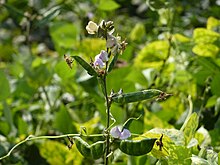
FAO na-ebipụta data mmepụta maka akwụkwọ nri n'ụdị atọ:
- Mkpụrụ osisi kpọrọ nkụ: mkpụrụ osisi niile tozuru etozu na nke kpọrọ nkụ nke ahịhịa leguminose ma e wezụga soybeans na groundnuts.
- Mmanụ: soybeans na groundnuts.
- Nri ọhụrụ: mkpụrụ osisi na-acha akwụkwọ ndụ akwụkwọ ndụ na-eto eto nke ahịhịa leguminus.
| Ihe ọkụkụ[FAO koodu] |
1961 | 1981 | 2001 | 2015 | 2016 | Ọnụ ọgụgụ 2016 /1961 |
Okwu |
|---|---|---|---|---|---|---|---|
| Ngụkọta nke pulses (akọrọ) [1726] | 40.78 | 41.63 | 56.23 | 77.57 | 81.80 | 2.01 | Templeeti:Left Per capita production had decreased. (Population increase was 2.4×) |
| Mmanụ a na-akụ (akọrọ) | |||||||
| Soyabeans [236] | 26.88 | 88.53 | 177.02 | 323.20 | 334,89 | 12.46 | Templeeti:Left Drastic increase driven by the demand for animal feeds and oil. |
| Akpụkpọ anụ, nwere mkpokoro [242] | 14.13 | 20.58 | 35.82 | 45.08 | 43.98 | 3.11 | |
| Nri ọhụrụ (mmiri 80-90%) | |||||||
| Beans, akwụkwọ ndụ akwụkwọ ndụ | 2.63 | 4.09 | 10.92 | 23.12 | 23.60 | 8.96 | |
| Peas, akwụkwọ ndụ akwụkwọ ndụ [417] | 3.79 | 5.66 | 12.41 | 19.44 | 19.88 | 5.25 | |
Ihe ọkụkụ ndị bụ isi nke "Pulses, Total (dry) " bụ "Beans, dry [176]" 26.83 nde tọn, "Peas, dry [187]" 14.36 nde tọn. "Chick peas [191]" 12.09 nde tọn., "Cow peas [195]" 6.99 nde tọn na-esote, "Lentils [201]" 6.32 nde tọn". "Pigeon peas [197]" 4.49 nde tọn N'ozuzu, oriri nke pulses kwa onye na-ebelata kemgbe 1961. Ewezuga ya bụ lentils na cowpeas.

| Country | 2016 | Share | Remarks | |
|---|---|---|---|---|
| Total | 81.80 | 100% | ||
| 1 | India | 17.56 | 21.47% | |
| 2 | Canada | 8.20 | 10.03% | |
| 3 | Myanmar | 6.57 | 8.03% | |
| 4 | China | 4.23 | 5.17% | |
| 5 | Nigeria | 3.09 | 3.78% | |
| 6 | Russia | 2.94 | 3.60% | |
| 7 | Ethiopia | 2.73 | 3.34% | |
| 8 | Brazil | 2.62 | 3.21% | |
| 9 | Australia | 2.52 | 3.09% | |
| 10 | USA | 2.44 | 2.98% | |
| 11 | Niger | 2.06 | 2.51% | |
| 12 | Tanzania | 2.00 | 2.45% | |
| Others | 24.82 | 30.34% |
Onye ndu ụwa na mmepụta nke agwa kpọrọ nkụ (Phaseolus spp), bụ India, Myanmar (Burma) na Brazil sochiri.[29] N'Africa, onye mmepụta kachasị mkpa bụ Tanzania.[30]
| Mba | Mmepụta (tonnes) |
Ihe odide ala ala ala |
|---|---|---|
| India | 5,460,000 | F |
| Myanmar | 3,053,012 | |
| Brazil | 3,035,290 | A |
| United States | 1,495,180 | * |
| China | 1,281,586 | |
| Tanzania | 1,267,648 | F |
| Mexico | 1,056,071 | |
| Kenya | 774,366 | F |
| Argentina | 633,823 | * |
| Uganda | 603,980 | |
| World | 27,545,942 | A |
Enweghị akara = ọnụ ọgụgụ gọọmentị, P = ọnụ ọgụgụ ọrụ gọọmentị، F = atụmatụ FAO, * = data na-abụghị nke gọọmentị / nke gọọmentụ / nke enyo, C = ọnụ ọgụgụ a gbakọrọ A = ngụkọta (ọ nwere ike ịgụnye onye ọrụ, nke gọọmentịa ma ọ bụ atụmatụ)
Ebe e si nweta ya: UN Food and Agriculture Organization (FAO[31])
Hụkwa
[dezie | dezie ebe o si]- Akị a na-eme achịcha
- agwa
- Mkpụrụ osisi na-awụli elu na Mexico
- Ndepụta ofe bean
- Fassoulada - ofe bean
- Ndepụta nke mkpụrụ ndị a na-eri eri
- Ndepụta nri legume
- Beans, Beans, Mkpụrụ Egwú
Ihe odide
[dezie | dezie ebe o si]- ↑ Beans and peas are unique foods | ChooseMyPlate. www.choosemyplate.gov. Retrieved on 2020-01-24.
- ↑ Clark. How to Cook Beans. New York Times Cooking. Retrieved on 3 January 2020.
- ↑ Kpọpụta njehie: Invalid
<ref>tag; no text was provided for refs namedMW_Collegiate - ↑ 4.0 4.1 Definition And Classification Of Commodities (See Chapter 4). FAO, United Nations (1994). Archived from the original on 2018-10-12. Retrieved on 2023-07-15.
- ↑ The Germination Of a Bean. Microscopy-uk.org.uk. Archived from the original on 2022-10-09. Retrieved on 18 November 2017.
- ↑ Kaplan, pp. 27 ff
- ↑ Gorman (1969). "Hoabinhian: A pebble-tool complex with early plant associations in southeast Asia". Science 163 (3868): 671–3. DOI:10.1126/science.163.3868.671. PMID 17742735.
- ↑ "And as in some great threshing-floor go leaping From a broad pan the black-skinned beans or peas." (Iliad xiii, 589).
- ↑ Bitocchi (3 April 2012). "Mesoamerican origin of the common bean (Phaseolus vulgaris L.) is revealed by sequence data". Proceedings of the National Academy of Sciences 109 (14): E788–E796. DOI:10.1073/pnas.1108973109. PMID 22393017.
- ↑ Kaplan, p. 30: Domestication, besides involving selection for larger seed size, also involved selection for pods that did not curl and open when ripe, scattering the beans they contained.
- ↑ Kaplan, p. 30
- ↑ Pardo B. (2014). Chile: Plantas alimentarias Prehispánicas, 2015 (in Spanish), Arica, Chile: Ediciones Parina, 162. ISBN 9789569120022.
- ↑ Laura McGinnis and Jan Suszkiw, ARS. Breeding Better Beans. Agricultural Research magazine. June 2006.
- ↑ Boston (2019-10-28). Legumes and Pulses (en-us). The Nutrition Source. Retrieved on 2022-04-07.
- ↑ Belsey (1973). "The epidemiology of favism". Bulletin of the World Health Organization 48 (1): 1–13. ISSN 0042-9686. PMID 4541143.
- ↑ Tarhani (2020-08-18). "Clinical Manifestations and Therapeutic Findings of the Children with Glucose-6-Phosphate Dehydrogenase Deficiency Presenting Favism". Endocrine, Metabolic & Immune Disorders Drug Targets 21 (6): 1125–1129. DOI:10.2174/1871530320999200818182905. ISSN 2212-3873. PMID 32811422.
- ↑ Raina (2011). "Quantitative Determination of L-DOPA in Seeds of Mucuna Pruriens Germplasm by High Performance Thin Layer Chromatography". Indian Journal of Pharmaceutical Sciences 73 (4): 459–462. DOI:10.4103/0250-474X.95651. ISSN 0250-474X. PMID 22707835.
- ↑ Schrenk (2019-11-05). "Scientific opinion on the risks for animal and human health related to the presence of quinolizidine alkaloids in feed and food, in particular in lupins and lupin‐derived products". EFSA Journal 17 (11): e05860. DOI:10.2903/j.efsa.2019.5860. ISSN 1831-4732. PMID 32626161.
- ↑ Haque (1996). "Epidemiological Study of Lathyrism in Northwestern Districts of Bangladesh" (in english). Neuroepidemiology 15 (2): 83–91. DOI:10.1159/000109893. ISSN 0251-5350. PMID 8684587.
- ↑ Jahan (February 1993). "Studies on neurolathyrism". Environmental Research 60 (2): 259–266. DOI:10.1006/enrs.1993.1035. ISSN 0013-9351. PMID 8472656.
- ↑ Shimelis (2008). "Influence of natural and controlled fermentations on α-galactosides, antinutrients and protein digestibility of beans (Phaseolus vulgaris L.)" (in en). International Journal of Food Science & Technology 43 (4): 658–665. DOI:10.1111/j.1365-2621.2006.01506.x. ISSN 1365-2621.
- ↑ Summary: Fermentation 'improves nutritional value of beans' (Sub Saharan Africa page, Science and Development Network website). Paper: Influence of natural and controlled fermentations on α-galactosides, antinutrients and protein digestibility of beans (Phaseolus vulgaris L.)
- ↑ Sprouts: What You Should Know. Retrieved on 23 January 2016.
- ↑ Shiga toxin-producing E. coli (STEC): Update on outbreak in the EU (27 July 2011, 11:00). European Centre for Disease Prevention and Control (2011-07-27). Archived from the original on 2017-03-15.
- ↑ "Health | Experts make flatulence-free bean", BBC News, 25 April 2006. Retrieved on 25 February 2009.
- ↑ Flatulence – Overview – Introduction. Nhs.uk. Archived from the original on 21 February 2009. Retrieved on 25 February 2009.
- ↑ Harold McGee (2003). Food and Cooking. Simon & Schuster. ISBN 978-0684843285. “Many legumes, especially soy, navy and lima beans, cause a sudden increase in bacterial activity and gas production a few hours after they're consumed. This is because they contain large amounts of carbohydrates that human digestive enzymes can't convert into absorbable sugars. These carbohydrates therefore leave the upper intestine unchanged and enter the lower reaches, where our resident bacterial population does the job we are unable to do.”
- ↑ Peter Barham (2001). The Science of Cooking. Springer. ISBN 978-3-540-67466-5. “we do not possess any enzymes that are capable of breaking down larger sugars, such as raffinose etc. These 3, 4 and 5 ring sugars are made by plants especially as part of the energy storage system in seeds and beans. If these sugars are ingested, they can't be broken down in the intestines; rather, they travel into the colon, where various bacteria digest them – and in the process produce copious amounts of carbon dioxide gas”
- ↑ Dry beans does not include broad beans, dry peas, chickpea, lentil.
- ↑ FAO Pulses and Derived Products.
- ↑ Major Food And Agricultural Commodities And Producers – Countries By Commodity. Fao.org. Archived from the original on 6 September 2015. Retrieved on 2 February 2015.
Kpọpụta njehie: <ref> tag with name "Chazan" defined in <references> group "" has no content.
